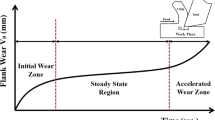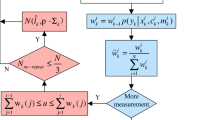Abstract
The quality of the dicing will be impacted if the tool wears out quickly during the dicing operation. If the crew changes the tool in a timely manner, the workpieces’ quality of dicing is guaranteed. Therefore, for actual production, estimating the tool’s remaining usable life (RUL) is crucial. A model was proposed in the research to predict the RUL of dicing tool. The back-propagation neural network (BP) and the particle swarm optimization (PSO) algorithm are combined in the model. The model is also known as the PSO-BP prediction model, where the inertia weight of the PSO method can be changed in a more real-time and dynamic way. After several experiments, comparing the experimental results of the proposed model with two traditional models, it was found that the accuracy of the PSO prediction model improved by 0.664% over the BP prediction model and by 0.661% over the traditional PSO-BP (also called as TPSO-BP) prediction model. This concludes that the proposed prediction model is used to predict the RUL of the tool; the results will be more accurate, so the staff can replace the tool in time to ensure the quality and productivity.


















Similar content being viewed by others
References
Lin JW, Cheng MH (2014) Investigation of chipping and wear of silicon wafer dicing. J Manuf Process 16(3):373–378
Jeon S, Zolfaghari A, Lee CB (2018) Dicing wheel wear monitoring technique utilizing edge diffraction effect. Measurement 121:139–143
Tobon-Mejia DA, Medjaher K, Zerhouni N, Zerhouni N (2012) A data-driven failure prognostics method based on mixture of Gaussians hidden Markov models. IEEE Trans Reliab 61(2):491–503
Si XS, Wang WB, Hu CH, Zhou DH (2011) Remaining useful life estimation — a review on the statistical data driven approaches. Eur J Oper Res 213(1):1–14
Bezazi A, Pierce SG, Worden K (2007) Fatigue life prediction of sandwich composite materials under flexural tests using a Bayesian trained artificial neural network. Int J Fatigue 29(4):738–747
Ren L, Sun YQ, Cui J, Zhang L (2018) Bearing remaining useful life prediction based on deep autoencoder and deep neural networks. J Manuf Syst 48:71–77
Zhou JT, Zhao X, Gao J (2019) Tool remaining useful life prediction method based on LSTM under variable working conditions. Int J Adv Manuf Technol 104(9–12):4715–4726
Sun HB, Cao DL, Zhao ZD, Kang X (2018) A hybrid approach to cutting tool remaining useful life prediction based on the Wiener process. IEEE Trans Reliab 67(3):1294–1303
An QL, Tao ZR, Xu XW, El Mansori M, Chen M (2020) A data-driven model for milling tool remaining useful life prediction with convolutional and stacked LSTM network. Measurement 154:107461
Yu JS, Liang S, Tang DY, Liu H (2016) A weighted hidden Markov model approach for continuous-state tool wear monitoring and tool life prediction. Int J Adv Manuf Technol 91(1–4):201–211
Xue H, Wang SL, Yi LL, Zhu R, Cai B, Sun SL (2015) Tool life prediction based on particle swarm optimization–back-propagation neural network. Proc Inst Mech Eng Part B: J Eng Manuf 229(10):1742–1752
Xu FY, Pun CM, Li HL, Zhang YS, Song YR, Gao H (2020) Training Feed-Forward Artificial Neural Networks with a modified artificial bee colony algorithm. Neurocomputing 416:69–84
Aljarah I, Faris H, Mirjalili S (2018) Optimizing connection weights in neural networks using the whale optimization algorithm. Soft Comput 22(1):1–15
Xue Y, Tang T, Liu AX (2019) Large-scale feedforward neural network optimization by a self-adaptive strategy and parameter based particle swarm optimization. IEEE Access 7:52473–52483
Bai B, Zhang JY, Wu X, Zhu GW, Li XY (2021) Reliability prediction-based improved dynamic weight particle swarm optimization and back propagation neural network in engineering systems. Expert Syst Appl 177
Ren C, An N, Wang JZ, Li L, Hu B, Shang D (2014) Optimal parameters selection for BP neural network based on particle swarm optimization: a case study of wind speed forecasting. Knowl-Based Syst 56:226–239
Li GX, Tan ZW, Xu WK, Xu F, Wang L, Chen J, Wu K (2021) A particle swarm optimization improved BP neural network intelligent model for electrocardiogram classification. BMC Med Inform Decis Mak 21(S2)
Huang LJ, Xie GJ, Zhao WD, Gu Y, Huang Y (2021) Regional logistics demand forecasting: a BP neural network approach. Complex Intell Syst 1:1–16
Zhang LP, Wu K, Zhong YF, Li PX (2008) A new sub-pixel mapping algorithm based on a BP neural network with an observation model. Neurocomputing 71(10):2046–2054
Wu S (2018) A hybrid method of ultrafast laser dicing and high density plasma etching with water soluble mask for thin silicon wafer cutting. Mater Sci Semicond Process 74:64–73
Chen FJ, Ye XQ, Yin SH, Ye QS, Huang S, Tang QC (2019) Automated vision positioning system for dicing semiconductor chips using improved template matching method. Int J Adv Manuf Technol 100(9–12):2669–2678
Su TJ, Chen YF, Cheng JC, Chiu CL (2018) Optimizing the dicing saw parameters of 60 μm wafer dicing street. Microsystem Technologies
Qu ZX, Mao WQ, Zhang KQ, Zhang WY, Li ZP (2018) Multi-step wind speed forecasting based on a hybrid decomposition technique and an improved back-propagation neural network. Renew Energy 133:919–929
Kennedy J, Eberhart R (1995) Particle Swarm Optimization Icnn95-international Conference on Neural Networks. IEEE
Muñoz-Escalona P, Díaz N, Cassier Z (2012) Prediction of tool wear mechanisms in face milling AISI 1045 steel. J Mater Eng Perform 21(6):797–808
Cao XY, Zhang XX (2020) Hybrid particle swarm algorithm for learning factor adjustment with weights. Computer Technol Dev 30(11):30–36 (In Chinese)
Funding
This work was supported by Major Science and Technology Special Projects in Henan Province with item number “201200210300.”
Author information
Authors and Affiliations
Contributions
Jun Shi and Yanyan Zhang conceived and designed the study. Yanyan Zhang performed the experiments and wrote the manuscript. Jun Shi and Yahui Sun contributed to the data interpretation. Weifeng Cao and Lintao Zhou reviewed and edited the manuscript. All authors commented on previous versions of the manuscript. All authors read and approved the manuscript.
Corresponding author
Ethics declarations
Competing interests
The authors declare no competing interests.
Additional information
Publisher's Note
Springer Nature remains neutral with regard to jurisdictional claims in published maps and institutional affiliations.
Rights and permissions
Springer Nature or its licensor (e.g. a society or other partner) holds exclusive rights to this article under a publishing agreement with the author(s) or other rightsholder(s); author self-archiving of the accepted manuscript version of this article is solely governed by the terms of such publishing agreement and applicable law.
About this article
Cite this article
Shi, J., Zhang, Y., Sun, Y. et al. Tool life prediction of dicing saw based on PSO-BP neural network. Int J Adv Manuf Technol 123, 4399–4412 (2022). https://doi.org/10.1007/s00170-022-10466-y
Received:
Accepted:
Published:
Issue Date:
DOI: https://doi.org/10.1007/s00170-022-10466-y




